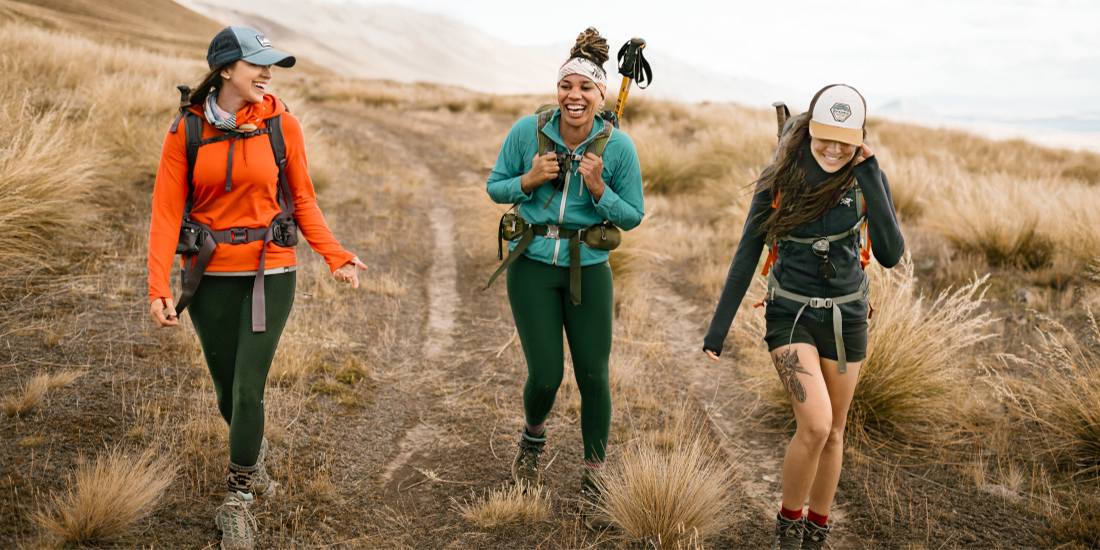I don’t feel like I need to match my pack to my Buff when it comes to outdoor fashion, but during a backcountry ski tour in Colorado’s San Juan Mountains a few years ago, I noticed that my guide was dressed a lot differently than I was. I was following Angela Hawse, a ridiculously skilled mountaineer who’s climbed all over the world and can positively fly up peaks using skis, ropes, ice axes or hiking boots. She wore four layers: a base layer, a fleece pullover, a puffy jacket and an insulated shell. I, meanwhile, wore just two: an ultralight shell over a thin wool crewneck. Had we read differing weather reports?
We were both skiing uphill in 18°F cold and light snow, but my body registered moderate exertion while her superfit system registered none. The group’s pace was too slow to keep Hawse warm without her four insulating layers.
That may have been my first lesson in the ways that group dynamics influence layering choices, but it wasn’t my last. Once I became a parent, my outfits changed dramatically based on whether I carried my daughter in a hiking backpack (a quick-drying synthetic base layer sufficed) or marched oh-so-slowly behind her as she learned to take her own steps down the trail (necessitating another mid layer for Mama).
On hikes with my friends, I noticed that the group’s snack preferences often made me reconsider my layering, too: Lingering at an exposed viewpoint for a gourmet picnic generally left me too chilly to appreciate the Brie—or the vista. Other trips were more eat-as-you-go affairs, and for those, I could not peel off my mid layer quick enough.
There is no substitution for understanding how different materials work together to keep you comfortable outside, but I’ve learned over decades of hiking, skiing and mountain biking to assess more than just the weather forecast when deciding what clothing to wear and pack. To keep my temperature regulated, I consider group dynamics. Here’s how.

Know your relative pace
Are you the group’s tortoise or its hare? As Hawse illustrated for me on that February morning, you will want to dress according to your relative fitness. Slower members of the group should choose lightweight layers that will help them stay cool and dry while they hurry to keep up with speedier companions. Tortoises’ pick: The Outdoor Research Echo T-Shirt ($42) is made of recycled polyester that mops up sweat and dries super fast. Hares can wear it too, though in addition, they’ll want to pack a breathable, insulated mid layer like the REI Co-op Groundbreaker Fleece Jacket 2.0 ($49.95) to keep them warm through slow-moving situations.
Consult the menu
I confess, I’m not a fan of eating big meals while on the trail. (For me, flooding my digestive system with lots of calories—fat, fiber and protein that my body has to break down—often ends up sapping my energy to hike. In cold weather, big meals also make it harder for my body to stay warm, because my blood gets diverted from circulation to digestion.) But many of my trail buddies enjoy lavish snack breaks and decadent picnics—and who can blame them? If you’ve packed single-origin chocolate or similar indulgences, it’s only fitting that you should pause to savor the snack. So I make it a point to pack extra layers when I’m sporting with gourmands. Oftentimes that’s a puffy like the Patagonia Nano Puff (starting at $199).
In mild or sunny weather, a long-sleeve sun shirt like the Carve Designs Lake Sunshirt ($62) offers enough coverage and UV protection to stay comfortable when not moving during lunch.

Measure your alcohol content
The closest I’ve ever come to hypothermia happened one New Year’s Day, as I skied down to my car from Margy’s Hut in central Colorado. The movement of my limbs grew spastic, and my emotions erupted in similarly strange bursts—but the culprit wasn’t the morning’s 10°F temperature. It was the fact that on New Year’s Eve the night prior, my friends and I drank like sailors on shore leave, and my resulting dehydration hobbled my body’s ability to stay warm.
And alcohol-related dehydration isn’t only a winter threat. Because hypothermia can occur at 50°F or cooler, summer hikers can become dangerously cold on exposed summits, and autumn trips can quickly turn wintry with rain. The takeaway? Pack extra insulation when you’re hiking with a hangover.
Count your flock
Here’s an adventure truism: The larger your group, the more likely it is that you’ll need to stop to address somebody’s problem. Hunger, tiredness, a blistered toe—whatever—are all reasons the group may pit stop. So before you head out, ask yourself what you might need to stay comfortable during such a pause. On a blazing-hot summer day, pack a hat like the Sunday Afternoons Islander ($44) in case you find yourself standing around where shade is scarce. In cooler temperatures, bring a stocking cap, a puffy jacket and a rain shell to keep you warm during an unscheduled break.
